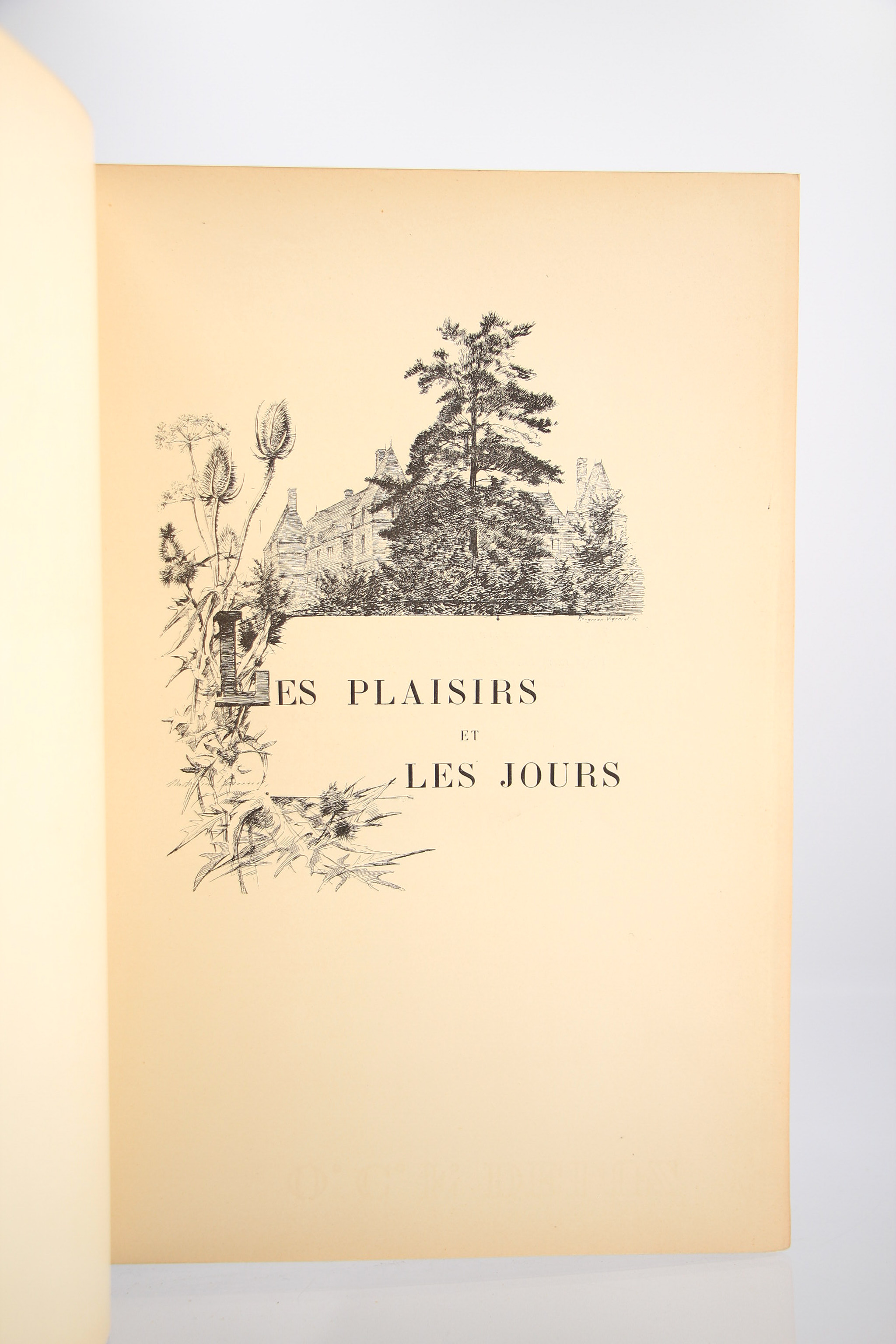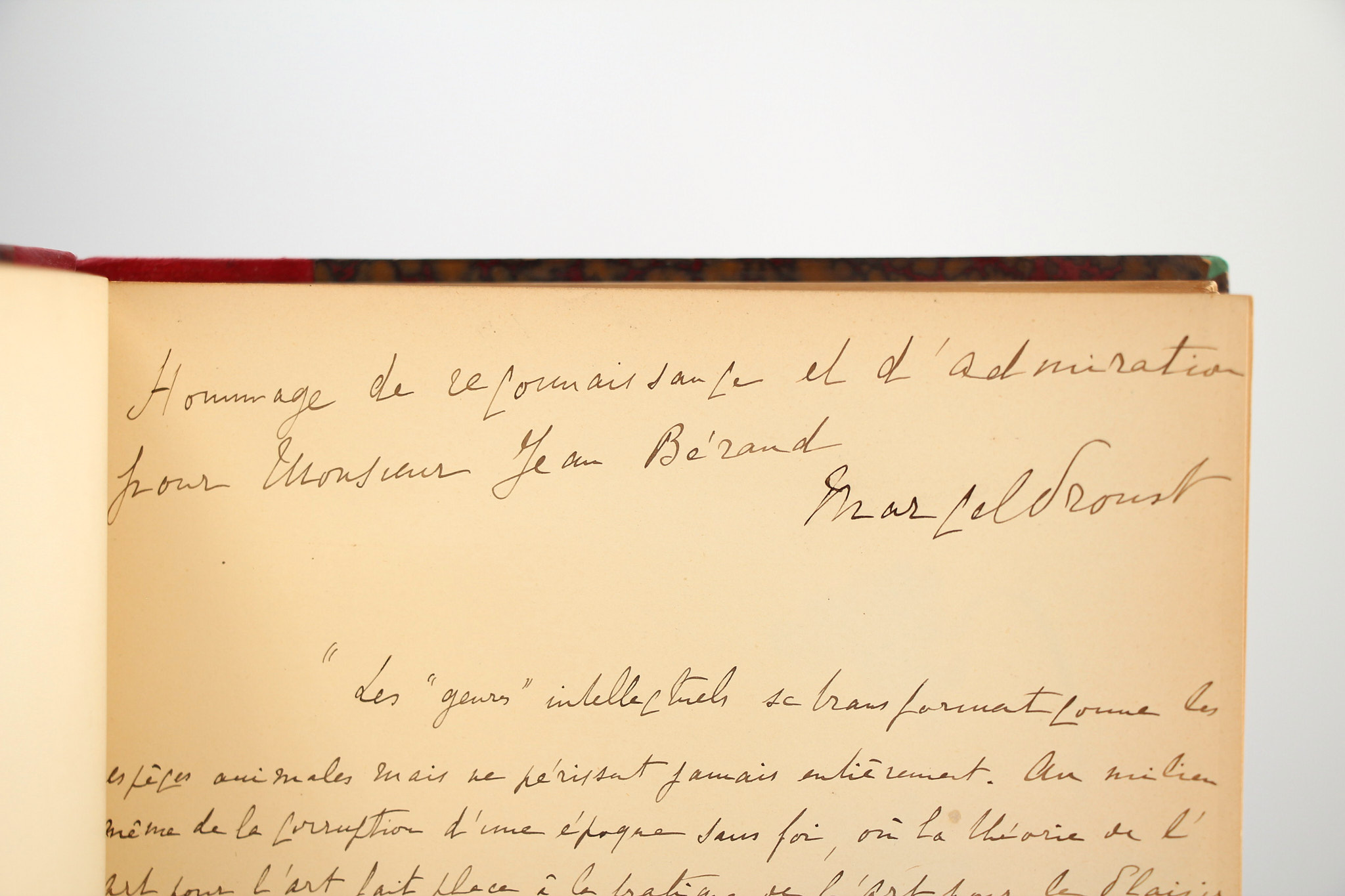First edition on ordinary paper, illustrated with drawings by Madeleine Lemaire including 14 inset, preface by Anatole France and scores by Reynaldo Hahn.
Bound in half red shagreen, spine in five compartments, marbled endpapers, large gilt lace tooling frame on the inner covers, wrappers and spine preserved, top edge gilt, gilt fillet on the leading edges, contemporary binding signed by Franz.
Exceptional handwritten dedication signed by Marcel Proust to the painter Jean Béraud followed by a long, entirely unpublished, handwritten, artistic profession of faith by Marcel Proust disguised as a false quotation “extrait[e] d'un vieux livre d'esthétique” (“extract from an old aesthetic book”).
Copy enriched with a signed original watercolour by Madeleine Lemaire.
In 1913, Jean Béraud will be, with Lucien Daudet, one of the only two dedicatees of
Du côté de chez Swann on Japan, of which he will receive the n°3 (Gaston Calmette's copy n°2 does not have a dedication and the last two copies on Japan paper will only be dedicated after 1918 to Jacques de Lacretelle and Louis Brun). This exceptional gift testifies less to the tribute of an artist than to the recognition of a man. Indeed, Jean Béraud was, in 1897, Marcel Proust's witness in the duel against Jean Lorrain, after his defamatory criticism of
Les Plaisirs et les Jours. A simple anecdote for Lorrain, for Proust the duel was a founding act that undoubtedly contributed to the emergence of a sense of legitimacy in the young socialite, until then hindered by his Jewish origins and his condition as a simple bourgeois, homosexual and journalist of barely 25 years of age. It was after this duel that Proust organised his first dinner “of the most literary and the most elegant – he himself reported in
Le Gaulois – which brought his many friends together for the first time”. “It is I who writes to you because it is I who hosts the dinner at my home”, insists Proust in his invitation letter to Robert de Montesquiou."
This Proustian First Supper (exactly 12 guests, no less!) launches Marcel's entry into literature and his inauguration by the great artistic and aristocratic society. Anatole France, the author of the preface for
Les Plaisirs et les Jours, is the central figure, surrounded by “some other distinguished men”, including the Marquis de Castellane, the Count Louis de Turenne, and in particular, the two witnesses of his transfiguration, Gustave Borda and Jean Béraud.
Although Jean Béraud's participation in Marcel Proust's accession will lead, fifteen years later, to this gift of a Japan copy of
Du côté de chez Swann, the origins of the friendship between the writer and the painter, motivating the duellist's daring request, remain obscure to date.
It was precisely at the home of the illustrator of
Les Plaisirs et les Jours, that the very young chronicler from
Le Figaro met, in the 90s, one of the main painters of Parisian life during the Belle époque, Jean Béraud, friend of Madeleine Lemaire and one of the first regulars at her Artistic, Literary and Social Salon. However, although several dinner acquaintances attest to their visits, neither Marcel Proust's biography, nor his correspondence, mentions any affinity between the two men until Proust's duel.
Although no one can ignore the deep intimacy of their respective works, sometimes even appearing to illustrate one another, Proust never alludes directly to Jean Béraud before 1897.
The dedication in this copy, until now unknown, is undoubtedly the first declaration of admiration that Marcel Proust addresses to this renowned painter whose aesthetic views and subjects of choice he shares. Far from a simple tribute of respectful and polite recognition, this dedication reveals the deep intellectual and artistic connivance between Proust and Béraud and sheds light on the events to come.
Marcel Proust was generous in dedications for this first work and there are at least 50 copies with autograph presentations out of only 300 copies that sold in 20 years. The publisher Calmann-Lévy complained in 1918 that he still had nearly 1200, most of them not still unbound. Marcel Proust having then partially disowned this first preliminary draft – today considered to be the true origin of
La Recherche – did not seek to resume its distribution after publication of
La Recherche began (the scarcity of copies on the market suggests a disappearance of the remaining stock).
However, in 1896, the illustrious unknown Marcel Proust, proud of his work that was produced in images by one whose “excellent talent extends to all genres” and made into music by Reynaldo Hahn, generously offered it to all his friends and regulars at the Salon de “la Patronne” (Madeleine's nickname which will become that of her literary projection, Mme Verdurin).
Modesty of youth, lack of confidence or the prestige of his dedicatees, the handwritten presentation of the young would-be writer is not forthcoming. Of the thirty or so strictly contemporary dedications that we have been able to identify, only one other is significant: the dedication to Madame Armand-Cavaillet, who obtained the prestigious preface from Anatole France for Proust, is indeed enriched with a long quotation from it.
It was not until 1899 that Proust embellished some precious copies with sumptuous, full-page, autograph epigraphs.
The importance of the dedication to Jean Béraud, written at the time of this edition – as the spelling of his signature, specific to this period, attests – is therefore an exception among the handwritten tributes and recognitions distributed by Proust.
However, the reproduction of an “old aesthetic book” by way of a tribute from a young 25-year-old man to a great painter 22 years his elder, with whom he does not share any proven complicity, is an even more surprising gesture.
And, indeed, the aforementioned quotation is in reality only a ruse to soften the audacity of Proust's praise for this admired painter and present him, under cover of a cloudy authority, a true analysis of his work and a personal and ambitious artistic theory.
The style and quality of writing made the actual attribution of this “extract” transparent. But even more, this unpublished text is a clear reference to the painting
La Madeleine chez le Pharisien (1891) in which Jean Béraud offers a modern vision of Jesus' visit to Simon the Pharisee. This scene from the Gospel is projected at a social dinner chaired by Renan, which features a number of Parisian characters including Eugène Chevreul, Alexandre Dumas fils, the socialist activist Albert Duc-Quercy and the demi-mondaine Liane de Pougy.
By an extraordinary coincidence, Proust's “old book” rightly praises the artist “with a generous heart subordinating Beauty to the highest ends that she expresses, adoring Christ, not as a curious dilettante of all archaisms, [...]but as a living reality, as a great moral fact that consciousness gradually releases from the antithetical environment of lamentable contemporary facts.”
The tribute is supported but without arrogance, free to spark off the appreciation or the indifference of the master. The following could only be flattery: “in such an artist [...] you will recognise the race of this Angelico who worked on a painting as he prayed.” However, it is much more than that.
Since what makes this unpublished thought important, is perhaps less what binds Proust to Béraud, but more its resonance with this other major aesthetic essay by Proust: “
Contre l'obscurité”, contemporary of the dedication since it was published on 15th July 1896 in the Revue Blanche.
As Jean-Yves Tadié notes, “Proust's aesthetic, formulated [in Contre l'obscurité] with vigour, will no longer change; it is therefore a capital date in the genealogy of his ideas.”
The parallel between the two texts is striking.
Both open with a reference to Darwin: “To stay alive, language must change with thought, lending itself to its new needs, like the feet of birds that will have to go on water” (C.O.) “The intellectual 'genres' are transformed like animal species” (V.L.E); continuing with a diatribe against the artistic poverty of his time: (C.O), “In the midst even of the corruption of a faithless era, where the theory of art for art makes way for the practice of art for pleasure” (V.L.E).
But unlike his article in the Revue Blanche, Proust's “Vieux livre d'Esthétique” reveals troubling similarities with Mallarmean aesthetics.
Although Proust relegates the theory of “Art for art” to a bygone era, he grants it greater relevance that he does to the current practices of “art for pleasure”. And if his gibes on “the indifferent and poetic symbol” and the“curious dilettante of all archaisms” (this same archaism whose charm Proust will praise a month later in connection with a poem by... Mallarmé, in corr. TII p.111), stigmatise his old Symbolist friends, his praise of “all those who, in every era of art, have thought that there was something more important than art itself and who made it, when expressed by art, the prize and the dignity” strongly qualifies the condemnation irrevocably of “
Contre l'obscurité”.
Here, under the double veil of an imaginary quote and real praise for his dedicatee, Proust expresses an artistic thought that follows his aesthetic dispute with Mallarmé. But correcting the aim of his article, he joins the Symbolist poet, no doubt in spite of himself, in the same quest for the Truth through Art. Whether this is expressed in the form of an apology for a Christlike art “in spirit and in truth”, or in the form of a “face to face with the Unspeakable or the Pure” (Mallarmé, Divagations, 1897), the same quest for Artistic Truth captures the two writers at the start of the literary and poetic adventure of the 20th century.
This exceptional unpublished dedication text by Marcel Proust to Jean Béraud on his first work is crucial in more ways than one.It is one of the only long dedications for Marcel Proust's first work, written strictly at the time and enriched in addition with an original watercolour by Madeleine Lemaire.
The donation of this unique copy lays the foundations, to date unknown, of the particular relationship that joined Proust to the dedicatee of the Japan n° 3
Swann.
Last but not least, this true artistic manifesto contributes to the elaboration of Proust's aesthetic theory suitable for structuring his immense work in the making.















